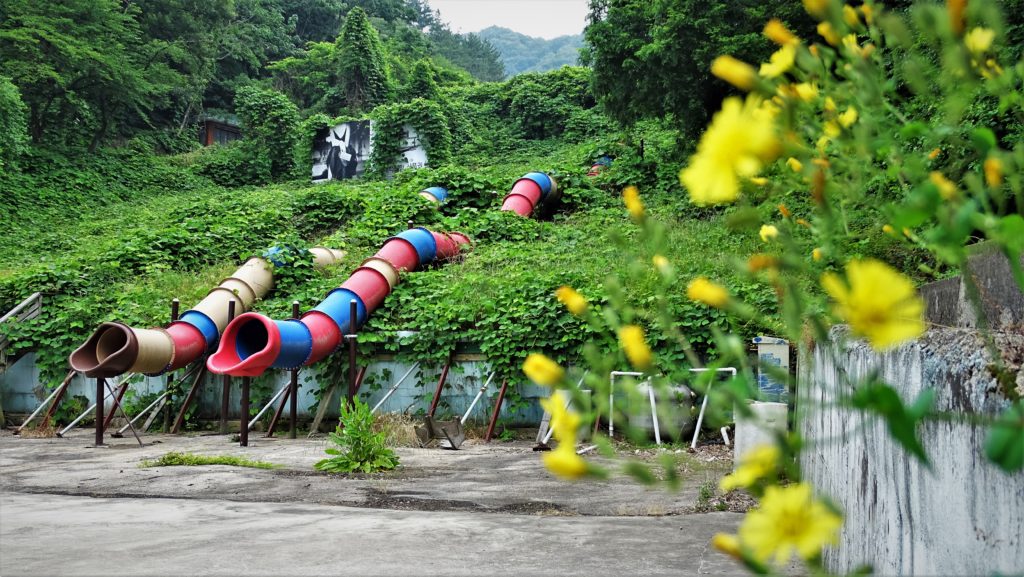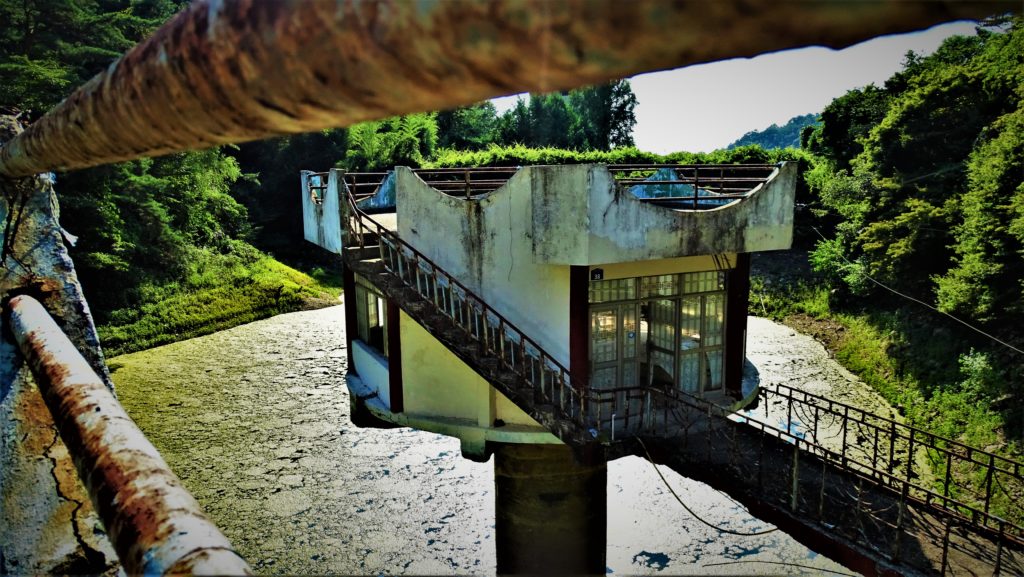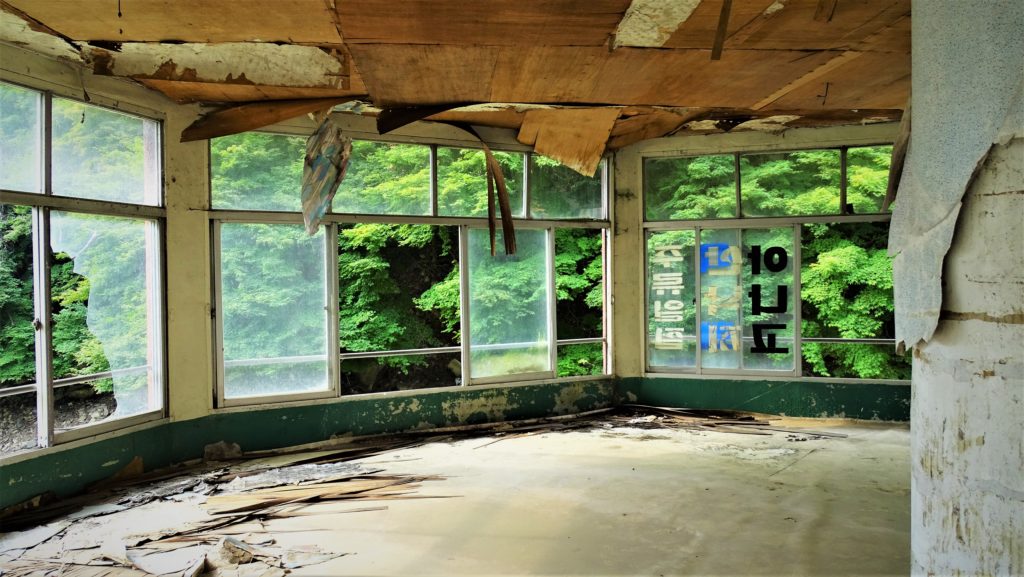Mudeung Park Land: The Little Amusement Park That Couldn’t
Written and photographed by Isaiah Winters
If you’ve ever taken Gwangju’s pleasant ski lift or acrophobia-inspiring monorail, then you might have noticed a derelict clutch of buildings nestled along the foothill opposite Hotel Mudeung Park. The overgrown site, known as Mudeung Park Land (무등파크랜드), is a failed amusement park that’s still listed on the hotel’s sitemap under “facilities.” Online pictures from the park’s glory days reveal a highly depressive alternative to Family Land, Gwangju’s top amusement park. By comparison, this makes Mudeung Park Land seem like the little amusement park that couldn’t, though that wasn’t always the case.
Mudeung Park Land is just one tiny part of a larger, far older amusement park that dates back to the late 1970s, making it Gwangju’s first. Named Jisan Amusement Park (지산유원지), it includes the hotel, driving range, monorail, ski lift, and amusement facilities seen in the area today. Since the company’s bankruptcy in 1994, however, only some of the facilities have remained functional, while others have fallen into various states of disrepair.

Today, anyone who pokes around the valley will quickly notice pockets of rot scattered all around. For example, right next to the ski lift terminal are two long, brightly colored waterslides that weave gradually in and out of the dense weeds before abruptly halting over the edge of a parking lot. Although the hotel’s website makes no mention of this seasonal waterpark facility, pictures from its heyday are still displayed on signboards in the hotel’s elevators. Based on the photos, the fixed plastic slides and other inflatable ones once disgorged riders into large metal-frame pools, some of which remained in use as late as 2013. In all likelihood, the place was a lot of fun at its peak and could still make a comeback.
The waterslides sit on a large slope that forms a reservoir where people used to be able to take boats out for a row. Rising from the reservoir lakebed are two octagonal pavilions with rooftops offering panoramic views of the now shallow, algae-covered water below. These two pavilions are connected to the shore and to each other by a badly water-damaged, forked bridge that’s been completely neglected. One of the two pavilions functioned as a panoramic restaurant serving eel, raw beef, and alcoholic beverages. The other’s windows are all covered in Disney cartoon stickers, suggesting it was a place for the kiddos to play while their parents enjoyed refreshments nearby. All that’s left inside the Disney-themed pavilion are large pieces of framed art, mostly orphaned calligraphy.

Mudeung Park Land, the little amusement park within Jisan Amusement Park, used to have a lot of facilities as well, though there’s not much left today. The ticket box still looks quite new and has a functioning public restroom inside. Its signboard lists a Viking ride, bumper and race cars, a “space fighter” ride, and a merry-go-round among the park’s facilities. It seems that visitors could pay to ride only the rides they wanted at 3,000 won a pop (and 2,000 won for kids). It would be a stellar place to photograph had the rides remained onsite in a sad, dilapidated state, but today all that remains are large concrete slab foundations and the odd snake. Mudeung Park Land’s largest remaining structure is its two-story restaurant, which, according to the neon light lettering on its façade, is “a space for both dreams and romance.” Now it’s just a jumble of broken windows and rotten furniture.
Big efforts are underway to redevelop Jisan Amusement Park’s wasted spaces. Nakyung International (나경인터내셔널), the company which acquired the park back in 2003, is seeking approval from Gwangju City’s Urban Planning Commission and local land owners to develop many new facilities, including a work experience center for children, an education center, a swimming pool, and new amusement facilities. However, the massive 200-billion-won project is being met with resistance from some local landowners and environmental groups and is therefore still being negotiated. If Nakyung International gets its way, redevelopment is set to begin as early as 2020. If it doesn’t, the valley will likely remain in disrepair.

Of interest to me is how the proposed redevelopment will affect the local landscape. Over at Hotel Mudeung Park’s blog, all I could find were a half dozen architectural renderings from 2013 showing some proposed redevelopment projects. In the computerized sketches, the park’s three-tiered Mudeung Mountain Octagonal Pavilion (무등산 팔각정), which already offers one of the best mountaintop views of Gwangju, has been given a new facelift, including rooftop access for better visibility and more extensive landscaping. While the proposed changes would offer better views of the city from a more stylish vantage point, they would also require a lot more trees to be cleared from the mountaintop.
Among the renderings, the most dramatic change was made to the monorail, which currently brings visitors to and from the mountaintop pavilion. In them, the iconic monorail has been replaced with an elevated boardwalk. Don’t worry – this doesn’t mean that the monorail is going to be scrapped. Back in 2013 when these renderings were posted, the monorail hadn’t been in operation for eight years, so Nakyung International was apparently considering removing it all together. Three years later, however, the company spent 2.1 billion won to reopen the monorail using new electric train cars instead of the old diesel-powered ones, so the city’s iconic death box in the sky is likely here to stay. If the elevated boardwalk had come to fruition instead, then many more trees would likely have to have been cleared to make way for an even worse eyesore than what already exists.

The remaining sketches show minor changes to the ski lift terminal and landscaping changes along the trail leading from the ski lift to the elevated boardwalk. Another small change gleaned from the sketches was made to the reservoir, which is now shown to have two sparkling white pavilions atop an ample lake of clean water. If actualized, this alone would beautify the area greatly. Lastly, the renderings show Mudeung Park Land, the little amusement park that couldn’t, cleared of its undergrowth and fully operational again, though without any rides for some reason.
In total, these relatively modest redevelopment sketches from 2013 would probably have resulted in a mixed bag of tradeoffs, including (1) more jobs and tourism in exchange for more noise, traffic, and pollution; (2) the beautification and better maintenance of some existing facilities in exchange for rarefying much of the local forest; and (3) the revival of an iconic amusement park close to downtown at the risk of it being just another redevelopment flop.
The current 200-billion-won redevelopment project, on the other hand, is likely to result in far more substantial changes to the valley than what’s shown in the outdated 2013 sketches. How exactly these changes may affect the area is yet unknown. Naturally, it would be best for the area’s many existing facilities to be redeveloped within their current footprints in the least invasive ways possible, though I’m skeptical that an investment this large will be anything but hugely transformative for the valley. Let’s hope either the city or local land owners can temper the extent of the current project; that way the project doesn’t result in the little amusement park that shouldn’t.
The Author
Originally from Southern California, Isaiah Winters first came to Gwangju in 2010. He recently returned to South Korea after completing his MA in Eastern Europe and is currently the chief proofreader for the Gwangju News. He enjoys writing, political science, and urban exploring.





